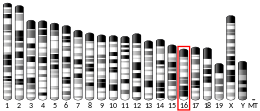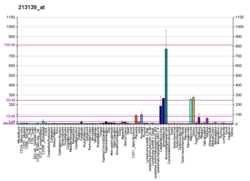SNAI2
Zinc finger protein SNAI2 is a transcription factor that in humans is encoded by the SNAI2 gene. It promotes the differentiation and migration of certain cells and has roles in initiating gastrulation.[5][6][7]
Function
This gene encodes a member of the Snail superfamily of C2H2-type zinc finger transcription factors. The encoded protein acts as a transcriptional repressor that binds to E-box motifs and is also likely to repress E-cadherin transcription in breast carcinoma. This protein is involved in epithelial-mesenchymal transitions and has antiapoptotic activity. It regulates differentiation and migration of neural crest cells along with other genes (e.g. FOXD3, SOX9 and SOX10, BMPs) in embryonic life. Mutations in this gene may be associated with sporadic cases of neural tube defects.[7][8]
SNAI2 downregulates expression of E-cadherin in premigratory neural crest cells; thus, SNAI2 induces tightly bound epithelial cells to break into a loose mesenchymal phenotype, allowing gastrulation of mesoderm in the developing embryo.[9][10] Structurally similar to anti-apoptotic Ces-1 in C. elegans, SLUG is a negative regulator of productive cell death in the developing embryo and adults.[9][11]
Clinical significance
Widely expressed in human tissues, SLUG is most notably absent in peripheral blood leukocytes, adult liver, and both fetal and adult brain tissues.[11] SLUG plays a role in breast carcinoma as well as leukemia by downregulation of E-cadherin, which supports mesenchymal phenotype by shifting expression from a Type I to Type II cadherin profile.[11][12] Maintenance of mesenchymal phenotype enables metastasis of tumor cells, though SLUG is expressed in carcinomas regardless to invasiveness.[9][10][11] A knockout model using chick embryos has also showed inhibition of mesodermal and neural crest delamination; chick embryo Slug gain of function appears to increase neural crest production.[9] Mutations in Slug are associated with loss of pregnancy during gastrulation in some animals.[9]
Interactions
BMPs precede expression of SLUG, and are suspected as the immediate upstream inducers of gene expression.[10][13]
References
- GRCh38: Ensembl release 89: ENSG00000019549 - Ensembl, May 2017
- GRCm38: Ensembl release 89: ENSMUSG00000022676 - Ensembl, May 2017
- "Human PubMed Reference:". National Center for Biotechnology Information, U.S. National Library of Medicine.
- "Mouse PubMed Reference:". National Center for Biotechnology Information, U.S. National Library of Medicine.
- Rhim H, Savagner P, Thibaudeau G, Thiery JP, Pavan WJ (Jan 1998). "Localization of a neural crest transcription factor, Slug, to mouse chromosome 16 and human chromosome 8". Mammalian Genome. 8 (11): 872–3. doi:10.1007/s003359900601. PMID 9337409.
- Cohen ME, Yin M, Paznekas WA, Schertzer M, Wood S, Jabs EW (August 1998). "Human SLUG gene organization, expression, and chromosome map location on 8q". Genomics. 51 (3): 468–71. doi:10.1006/geno.1998.5367. PMID 9721220.
- "Entrez Gene: SNAI2 snail homolog 2 (Drosophila)".
- Stegmann, K.; Boecker, J.; Kosan, C.; Ermert, A.; Kunz, J.; Koch, M. C. (August 1999). "Human transcription factor SLUG: mutation analysis in patients with neural tube defects and identification of a missense mutation (D119E) in the Slug subfamily-defining region". Mutation Research. 406 (2–4): 63–69. doi:10.1016/s1383-5726(99)00002-3. ISSN 0027-5107. PMID 10479723.
- Nieto MA (March 2002). "The snail superfamily of zinc-finger transcription factors". Nature Reviews Molecular Cell Biology. 3 (3): 155–66. doi:10.1038/nrm757. PMID 11994736.
- Carlson BM (2013). Human Embryology and Developmental Biology (5th ed.). Philadelphia, PA: Elsevier Health Sciences. pp. 101–102, 106, 313, 362, 382. ISBN 978-1-4557-2794-0.
- Inukai T, Inoue A, Kurosawa H, Goi K, Shinjyo T, Ozawa K, Mao M, Inaba T, Look AT (September 1999). "SLUG, a ces-1-related zinc finger transcription factor gene with antiapoptotic activity, is a downstream target of the E2A-HLF oncoprotein". Molecular Cell. 4 (3): 343–52. doi:10.1016/S1097-2765(00)80336-6. PMID 10518215.
- Kalluri R, Weinberg RA (June 2009). "The basics of epithelial-mesenchymal transition". The Journal of Clinical Investigation. 119 (6): 1420–8. doi:10.1172/jci39104. PMC 2689101. PMID 19487818.
- Sakai D, Wakamatsu Y (2005). "Regulatory mechanisms for neural crest formation". Cells Tissues Organs. 179 (1–2): 24–35. doi:10.1159/000084506. PMID 15942190.
Further reading
- Maruyama K, Sugano S (January 1994). "Oligo-capping: a simple method to replace the cap structure of eukaryotic mRNAs with oligoribonucleotides". Gene. 138 (1–2): 171–4. doi:10.1016/0378-1119(94)90802-8. PMID 8125298.
- Savagner P, Yamada KM, Thiery JP (June 1997). "The zinc-finger protein slug causes desmosome dissociation, an initial and necessary step for growth factor-induced epithelial-mesenchymal transition". The Journal of Cell Biology. 137 (6): 1403–19. doi:10.1083/jcb.137.6.1403. PMC 2132541. PMID 9182671.
- Suzuki Y, Yoshitomo-Nakagawa K, Maruyama K, Suyama A, Sugano S (October 1997). "Construction and characterization of a full length-enriched and a 5'-end-enriched cDNA library". Gene. 200 (1–2): 149–56. doi:10.1016/S0378-1119(97)00411-3. PMID 9373149.
- Stegmann K, Boecker J, Kosan C, Ermert A, Kunz J, Koch MC (August 1999). "Human transcription factor SLUG: mutation analysis in patients with neural tube defects and identification of a missense mutation (D119E) in the Slug subfamily-defining region". Mutation Research. 406 (2–4): 63–9. doi:10.1016/S1383-5726(99)00002-3. PMID 10479723.
- Inukai T, Inoue A, Kurosawa H, Goi K, Shinjyo T, Ozawa K, Mao M, Inaba T, Look AT (September 1999). "SLUG, a ces-1-related zinc finger transcription factor gene with antiapoptotic activity, is a downstream target of the E2A-HLF oncoprotein". Molecular Cell. 4 (3): 343–52. doi:10.1016/S1097-2765(00)80336-6. PMID 10518215.
- Hemavathy K, Guru SC, Harris J, Chen JD, Ip YT (July 2000). "Human Slug is a repressor that localizes to sites of active transcription". Molecular and Cellular Biology. 20 (14): 5087–95. doi:10.1128/MCB.20.14.5087-5095.2000. PMC 85958. PMID 10866665.
- Hajra KM, Chen DY, Fearon ER (March 2002). "The SLUG zinc-finger protein represses E-cadherin in breast cancer". Cancer Research. 62 (6): 1613–8. PMID 11912130.
- Sánchez-Martín M, Rodríguez-García A, Pérez-Losada J, Sagrera A, Read AP, Sánchez-García I (December 2002). "SLUG (SNAI2) deletions in patients with Waardenburg disease". Human Molecular Genetics. 11 (25): 3231–6. doi:10.1093/hmg/11.25.3231. PMID 12444107.
- Kajita M, McClinic KN, Wade PA (September 2004). "Aberrant expression of the transcription factors snail and slug alters the response to genotoxic stress". Molecular and Cellular Biology. 24 (17): 7559–66. doi:10.1128/MCB.24.17.7559-7566.2004. PMC 506998. PMID 15314165.
- Catalano A, Rodilossi S, Rippo MR, Caprari P, Procopio A (November 2004). "Induction of stem cell factor/c-Kit/slug signal transduction in multidrug-resistant malignant mesothelioma cells". The Journal of Biological Chemistry. 279 (45): 46706–14. doi:10.1074/jbc.M406696200. PMID 15337769.
- Uchikado Y, Natsugoe S, Okumura H, Setoyama T, Matsumoto M, Ishigami S, Aikou T (February 2005). "Slug Expression in the E-cadherin preserved tumors is related to prognosis in patients with esophageal squamous cell carcinoma". Clinical Cancer Research. 11 (3): 1174–80. PMID 15709186.
- Tripathi MK, Misra S, Khedkar SV, Hamilton N, Irvin-Wilson C, Sharan C, Sealy L, Chaudhuri G (April 2005). "Regulation of BRCA2 gene expression by the SLUG repressor protein in human breast cells". The Journal of Biological Chemistry. 280 (17): 17163–71. doi:10.1074/jbc.M501375200. PMC 3092429. PMID 15734731.
- Tripathi MK, Misra S, Chaudhuri G (April 2005). "Negative regulation of the expressions of cytokeratins 8 and 19 by SLUG repressor protein in human breast cells". Biochemical and Biophysical Research Communications. 329 (2): 508–15. doi:10.1016/j.bbrc.2005.02.006. PMC 3086003. PMID 15737616.
- Moody SE, Perez D, Pan TC, Sarkisian CJ, Portocarrero CP, Sterner CJ, Notorfrancesco KL, Cardiff RD, Chodosh LA (September 2005). "The transcriptional repressor Snail promotes mammary tumor recurrence". Cancer Cell. 8 (3): 197–209. doi:10.1016/j.ccr.2005.07.009. PMID 16169465.
- Chen M, Chen LM, Chai KX (June 2006). "Androgen regulation of prostasin gene expression is mediated by sterol-regulatory element-binding proteins and SLUG". The Prostate. 66 (9): 911–20. doi:10.1002/pros.20325. PMID 16541421.
- Turner FE, Broad S, Khanim FL, Jeanes A, Talma S, Hughes S, Tselepis C, Hotchin NA (July 2006). "Slug regulates integrin expression and cell proliferation in human epidermal keratinocytes". The Journal of Biological Chemistry. 281 (30): 21321–31. doi:10.1074/jbc.M509731200. PMID 16707493.




